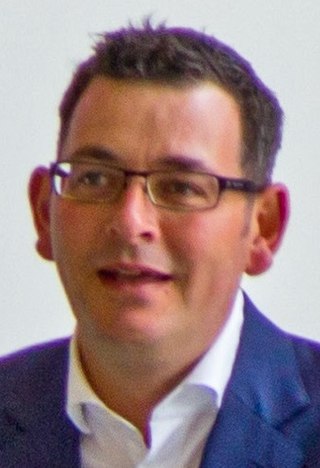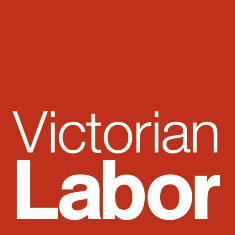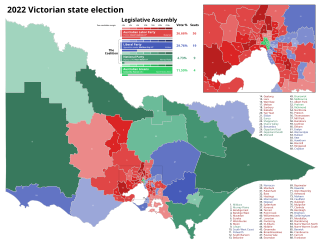
An election is a formal group decision-making process by which a population chooses an individual or multiple individuals to hold public office.

Party primaries or primary elections are elections in which a political party selects a candidate for an upcoming general election. Depending on the country and administrative division, there may be an "open primary", in which all voters are eligible to participate, or a "closed primary", in which only members of a political party can vote.
The Liberal Party was a parliamentary party in Australian federal politics between 1909 and 1917. The party was founded under Alfred Deakin's leadership as a merger of the Protectionist Party and Anti-Socialist Party, an event known as the Fusion.
Elections in Australia take place periodically to elect the legislature of the Commonwealth of Australia, as well as for each Australian state and territory and for local government councils. Elections in all jurisdictions follow similar principles, although there are minor variations between them. The elections for the Australian Parliament are held under the federal electoral system, which is uniform throughout the country, and the elections for state and territory Parliaments are held under the electoral system of each state and territory. An election day is always a Saturday, but early voting is allowed in the lead-up to it.
Branch stacking is a term used in Australian politics to describe the act of recruiting or signing up members for a local branch of a political party for the principal purpose of influencing the outcome of internal preselection of candidates for public office, or of inordinately influencing the party's policy.
Edmund Denis Casey, known as Ed, was best known as the leader of the Australian Labor Party in Queensland between 1978 and 1982. He also served as Primary Industries Minister in the government of Wayne Goss between 1989 and 1995. Casey was the member for Mackay in the Legislative Assembly of Queensland between 1969 and 1995.
Belinda Jane Neal is an Australian politician. She currently leads the Labor Party on Central Coast Council in New South Wales.
This article provides details on candidates who stood at the 2007 Australian federal election.

The 2005 Werriwa by-election was held in the Australian electorate of Werriwa in south-western Sydney on 19 March 2005, after the resignation of Labor MP Mark Latham, who had represented the electorate since 1994. Latham had been federal Opposition Leader since 2 December 2003 and led Labor to defeat at the 2004 election. He had become increasingly dissatisfied with politics and was struggling with recurring pancreatitis. He announced his resignation from parliament on 18 January 2005.
The Curtin Labor Alliance (CLA) was a minor Australian political party established in 2000. It was affiliated with the LaRouche Movement and was formed in Western Australia as a joint venture of the Citizens Electoral Council (CEC) and the Municipal Employees Union of Western Australia. The party's chairman was former Australian Labor Party (ALP) MP Adrian Bennett.

The 2002 Cunningham by-election was held in the Australian electorate of Cunningham in New South Wales on 19 October 2002. The by-election was triggered by the resignation of the sitting member, the Australian Labor Party's Stephen Martin on 16 August 2002. The writ for the by-election was issued on 16 September 2002.

Pippa Norris is a British American political scientist specializing in comparative politics. She is the McGuire Lecturer in Comparative Politics at the Harvard Kennedy School at Harvard University, and she has served as the Australian Laureate Fellow and Professor of Government and International Relations at the University of Sydney, and Director of the Electoral Integrity Project.

A by-election for the Australian House of Representatives division of Werriwa was held on 29 January 1994. It was triggered by the resignation of sitting Labor Party member and former minister John Kerin.

Stephen Patrick Jones is an Australian politician who represents the Division of Whitlam for the Australian Labor Party. He was elected at the 2010 Australian federal election and is the current Assistant Treasurer and Minister for Financial Services.

The 2014 Victorian state election, held on Saturday, 29 November 2014, was for the 58th Parliament of Victoria. All 88 seats in the Victorian Legislative Assembly and 40 seats in the Victorian Legislative Council were up for election. The incumbent centre-right Coalition minority government, led by Liberal Party leader and Premier Denis Napthine and National Party leader and Deputy Premier Peter Ryan, was defeated by the centre-left Labor Party opposition, led by Daniel Andrews. The Greens won two lower house seats, their first Legislative Assembly seats in a Victorian state election, whilst increasing their share of upper house seats. The new Andrews Ministry was sworn in on 4 December 2014.

The Victorian Labor Party, officially known as the Australian Labor Party and commonly referred to simply as Victorian Labor, is the Victorian state branch of the Australian Labor Party (ALP). Victorian Labor forms the incumbent government in the state of Victoria and is led by Jacinta Allan, who has served concurrently as Premier of Victoria since 2023.
The Tasmanian Liberal League was a political party in the Australian state of Tasmania. It was founded in 1909 and merged into the Nationalist Party in 1917. During its existence it formed a two-party system in the Parliament of Tasmania with the Australian Labor Party (ALP). Although the league was created in the same year as the federal Liberal Party, there were no formal ties between the two.

The 2022 Australian federal election was held on Saturday 21 May 2022 to elect members of the 47th Parliament of Australia. The incumbent Liberal/National Coalition government, led by Prime Minister Scott Morrison, sought to win a fourth consecutive term in office but was defeated by the opposition Labor Party, led by Anthony Albanese. Up for election were all 151 seats in the lower house, the House of Representatives, as well as 40 of the 76 seats in the upper house, the Senate.

The 2022 Victorian state election was held on Saturday, 26 November 2022 to elect the 60th Parliament of Victoria. All 88 seats in the Legislative Assembly and all 40 seats in the Legislative Council were up for election at the time the writs were issued, however the election in the district of Narracan was deferred due to the death of a candidate.

The 2023 Aston by-election was held on 1 April 2023 to elect the next member of the Australian House of Representatives in the electorate of Aston in Victoria.












